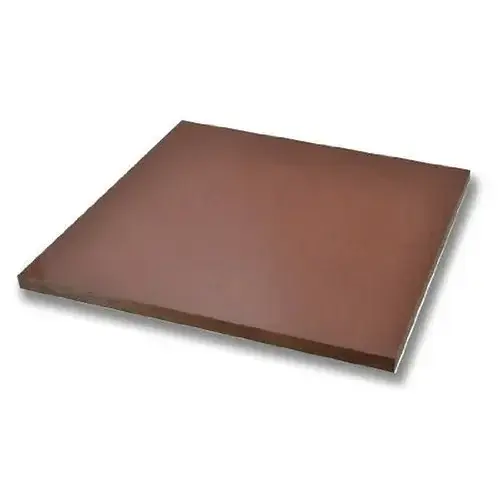How Does Phenolic Cotton Sheet Enhance Structural Strength?
Composite Structure and Load Distribution
The unique composite structure of phenolic cotton sheet significantly enhances its structural strength. The cotton fabric provides a strong foundation, while the phenolic resin impregnation creates a matrix that binds the fibers together. This synergistic combination results in a material that excels at distributing loads evenly across its surface. The interwoven cotton fibers act as a network, dispersing stress and preventing localized weak points. Consequently, phenolic cotton sheet exhibits superior resistance to bending, twisting, and impact forces, making it an ideal choice for applications requiring high structural integrity.
Resistance to Environmental Factors
Phenolic cotton sheet's enhanced structural strength is further bolstered by its remarkable resistance to environmental factors. The phenolic resin imparts excellent chemical resistance, protecting the material from degradation caused by oils, solvents, and other corrosive substances commonly encountered in mechanical engineering applications. Moreover, the sheet's low moisture absorption properties contribute to its dimensional stability, ensuring that it maintains its structural integrity even in humid or wet conditions. This resistance to environmental factors makes phenolic cotton sheet a reliable choice for components exposed to harsh operating conditions.
Thermal Stability and Strength Retention
Another key factor in the structural strength of phenolic cotton sheet is its impressive thermal stability. The material can maintain its mechanical properties over a wide range of temperatures, typically up to 120°C. This thermal stability ensures that components made from phenolic cotton sheet retain their strength and dimensional accuracy even under elevated temperature conditions. The ability to withstand heat without significant deformation or loss of strength is particularly valuable in mechanical engineering applications where thermal cycling or exposure to high temperatures is common, such as in automotive or industrial machinery components.
Key Mechanical Properties of Phenolic Cotton Sheet
Tensile and Compressive Strength
Phenolic cotton sheet boasts impressive tensile and compressive strength, attributes that are fundamental to its success in mechanical engineering applications. The material's high tensile strength allows it to withstand substantial pulling forces without failure, making it suitable for load-bearing components. Similarly, its excellent compressive strength enables it to resist deformation under heavy loads, a critical property for components subjected to constant pressure or weight. These strength characteristics stem from the tight bonding between the cotton fibers and the phenolic resin matrix, creating a robust material capable of maintaining its integrity under diverse stress conditions.
Flexural Rigidity and Impact Resistance
The flexural rigidity of phenolic cotton sheet is another key mechanical property that sets it apart in engineering applications. This property refers to the material's ability to resist bending under applied loads, a crucial factor in maintaining the shape and function of structural components. Phenolic cotton sheet's high flexural rigidity ensures that parts made from this material retain their designed form even when subjected to bending forces. Additionally, the material exhibits excellent impact resistance, absorbing and dissipating energy from sudden impacts without cracking or shattering. This combination of flexural rigidity and impact resistance makes phenolic cotton sheet an ideal choice for components that may encounter occasional shocks or impacts during operation.
Dimensional Stability and Creep Resistance
Dimensional stability is a critical mechanical property of phenolic cotton sheet that contributes significantly to its reliability in engineering applications. The material maintains its dimensions and shape over time, even when exposed to varying environmental conditions such as temperature fluctuations or humidity changes. This stability ensures that components maintain their precise fit and function throughout their operational life. Furthermore, phenolic cotton sheet demonstrates exceptional creep resistance, meaning it resists gradual deformation under constant stress over extended periods. This property is particularly valuable in applications where long-term reliability and precision are paramount, such as in gears, bearings, or structural supports that must maintain their dimensions under continuous load.
Advantages in Reducing Wear and Friction in Engineering Components
Self-Lubricating Properties
One of the most notable advantages of phenolic cotton sheet in mechanical engineering is its self-lubricating properties. The material's unique composition allows it to form a thin lubricating film on its surface during operation, effectively reducing friction between moving parts. This self-lubricating characteristic is particularly beneficial in applications where external lubrication is impractical or undesirable. By minimizing friction, phenolic cotton sheet components contribute to smoother operation, reduced energy consumption, and extended service life of mechanical systems. The self-lubricating nature also helps in maintaining consistent performance over time, as the material continues to provide lubrication throughout its operational life.
Abrasion Resistance and Durability
Phenolic cotton sheet exhibits exceptional abrasion resistance, a crucial property for components subject to continuous wear. The material's dense structure and the strong bonding between its cotton fibers and phenolic resin matrix result in a surface that resists scratching, gouging, and general wear from repeated contact or sliding. This high abrasion resistance translates to increased durability and longevity of engineering components, reducing the frequency of replacements and maintenance. In applications such as bearings, gears, or sliding surfaces, the use of phenolic cotton sheet can significantly extend the operational life of the entire mechanical system, leading to improved reliability and reduced lifecycle costs.
Low Coefficient of Friction
The inherently low coefficient of friction of phenolic cotton sheet is a key advantage in reducing wear in engineering components. This property ensures that surfaces made from this material slide easily against other materials, minimizing energy loss due to friction and reducing heat generation during operation. The low friction coefficient is particularly beneficial in applications involving relative motion between parts, such as in bearings, bushings, or sliding guides. By reducing friction, phenolic cotton sheet components contribute to smoother operation, lower power consumption, and decreased wear on mating surfaces. This characteristic not only enhances the efficiency of mechanical systems but also plays a crucial role in preventing premature failure due to frictional heating or wear.
Conclusion
Phenolic cotton sheet stands as a versatile and indispensable material in mechanical engineering, offering a unique blend of structural strength, key mechanical properties, and wear-reducing advantages. Its ability to enhance structural integrity, maintain dimensional stability, and provide self-lubrication makes it an optimal choice for a wide range of applications. As engineers continue to seek materials that offer both performance and longevity, phenolic cotton sheet remains at the forefront, driving innovation and efficiency in mechanical systems across various industries.
Contact Us
For more information about our high-quality phenolic cotton sheet products and how they can benefit your mechanical engineering projects, please contact us at info@jhd-material.com. Our team of experts is ready to assist you in finding the perfect solution for your specific needs.






